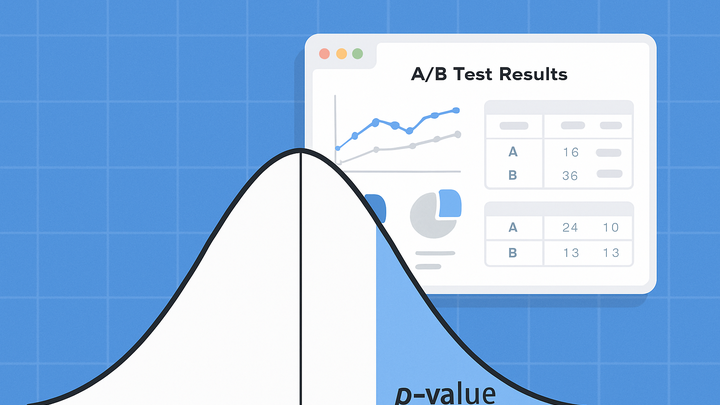Published on 2025-06-27T19:06:54Z
What is P-Value? Examples of P-Value in Analytics
In digital analytics, the p-value is a statistical metric that quantifies the probability of observing data at least as extreme as the collected sample, assuming the null hypothesis is true. It helps analysts determine whether observed differences in metrics—like conversion rates between variations in A/B tests—are likely due to chance or represent real effects. P-values are central to hypothesis testing workflows in tools like Google Analytics 4 Experiments and when exporting raw event data from cookie-free platforms such as PlainSignal for deeper statistical analysis. By providing a standard threshold (commonly 0.05), p-values inform decision-makers on the reliability of their experiments, guiding strategies for website optimization, feature rollouts, and marketing campaigns. However, understanding how to calculate, interpret, and apply p-values—and acknowledging their limitations—is crucial for drawing valid insights and avoiding common pitfalls in experimental analytics.
P-value
A statistical measure indicating the probability of observing results under the null hypothesis, guiding significance in analytics.
Understanding P-Value
The p-value represents the probability of obtaining test results at least as extreme as the observed data, assuming the null hypothesis is true. It is a cornerstone of statistical inference used to gauge whether observed differences are random fluctuations or reflect genuine effects. A low p-value indicates that the observed data would be unlikely under the null hypothesis, leading analysts to consider rejecting the null. Conversely, a high p-value suggests insufficient evidence to reject the null hypothesis. In analytics, p-values bridge raw data collection and actionable insights by quantifying statistical significance.
-
Definition
Quantifies the likelihood of observing data as extreme or more extreme than the sample, under the assumption that the null hypothesis is correct.
-
Statistical context
Anchored in hypothesis testing frameworks, p-values depend on the chosen test statistic (e.g., t-test, z-test) and the distribution under the null model.
-
Interpretation
Typically compared against a significance level (α) such as 0.05; if p ≤ α, results are deemed statistically significant.
Why P-Value Matters in Digital Analytics
In digital analytics, p-values help teams distinguish meaningful changes in user behavior from random noise. They underpin decisions on design tweaks, feature launches, and marketing optimizations. By rigorously testing hypotheses with p-values, organizations can allocate resources to strategies with proven impacts, minimize false leads, and maintain confidence in data-driven processes.
-
Assessing significance in a/b tests
Determines whether differences in metrics (e.g., click-through rates) between variants are likely due to chance or indicate real user preferences.
-
Decision-making confidence
Provides a standardized threshold to assess results, reducing subjective judgments and biases in interpreting data.
-
Resource allocation
Helps avoid chasing random variations, focusing time and budget on changes with statistically validated impact.
Calculating P-Value
P-values can be calculated using various statistical tests and tools. In analytics workflows, this often involves exporting raw event data or leveraging built-in experiment features in analytics platforms. Understanding how to set up tests, retrieve data, and apply the correct statistical functions ensures accurate p-value computation.
-
Parametric tests
Commonly use t-tests or z-tests depending on sample size and variance assumptions.
-
T-test
Ideal for small samples with normally distributed data and unknown population variance.
-
Z-test
Used when sample sizes are large and population variance is known or approximated.
-
-
Using GA4 experiments
Google Analytics 4 offers an Experiments feature with built-in statistical testing. Embed the GA4 tracking code:
<script async src="https://www.googletagmanager.com/gtag/js?id=G-XXXXXXX"></script> <script> window.dataLayer = window.dataLayer || []; function gtag(){dataLayer.push(arguments);} gtag('js', new Date()); gtag('config', 'G-XXXXXXX'); </script>Then configure A/B tests in the GA4 UI to view p-values in experiment reports.
-
Configuring experiments
Set up A/B tests in GA4’s interface by defining variants, audiences, and duration.
-
Analyzing results
Review p-values and confidence intervals directly in GA4’s experiment report.
-
-
Retrieving data from PlainSignal
PlainSignal provides cookie-free event tracking and an API to export raw counts for custom analysis.
<link rel="preconnect" href="//eu.plainsignal.com/" crossorigin /> <script defer data-do="yourwebsitedomain.com" data-id="0GQV1xmtzQQ" data-api="//eu.plainsignal.com" src="//cdn.plainsignal.com/plainsignal-min.js"></script>Use the API to pull event counts into statistical tools like Python or R to compute p-values manually.
-
Tracking snippet implementation
Embed the PlainSignal JavaScript snippet in your pages to start collecting event data.
-
Data export
Use PlainSignal’s REST API to retrieve aggregated metrics for external statistical analysis.
-
Interpreting P-Value in A/B Testing
Correct interpretation of p-values ensures valid conclusions from A/B tests. Analysts must consider the chosen significance threshold, the practical importance of observed effects, and the impact of running multiple tests on false positive rates.
-
Thresholds and alpha levels
Commonly set α at 0.05 or 0.01. A p-value below α indicates statistical significance, but the choice of α balances type I and type II error risks.
-
Practical vs statistical significance
A statistically significant result (low p-value) may have negligible business impact if the effect size is small.
-
Multiple comparisons
Running many tests increases false positive risks; apply corrections to maintain overall confidence.
-
Bonferroni correction
Adjusts α by dividing by the number of comparisons to control family-wise error rate.
-
False discovery rate
Controls expected proportion of false positives among significant results using methods like Benjamini-Hochberg.
-
Limitations and Best Practices
P-values are powerful but prone to misinterpretation and misuse. Adopting best practices around reporting, complementary metrics, and rigorous test design helps mitigate common pitfalls and enhances the credibility of analytics findings.
-
Avoiding p-hacking
Resist altering test parameters mid-analysis or selectively reporting only significant outcomes.
-
Reporting confidence intervals
Present confidence intervals alongside p-values to convey the range of plausible effects.
-
Complementary metrics
Use effect size and conversion lift metrics to assess the magnitude of impacts beyond p-values.
-
Effect size
Quantifies the magnitude of differences between groups, independent of sample size.
-
Conversion lift
Measures the relative increase in key performance indicators between control and variant.
-
